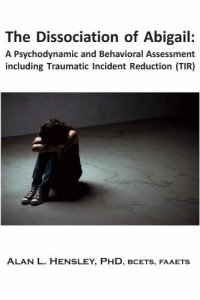
Ebook: The Dissociation of Abigail: A Psychodynamic and Behavioral Assessment including Traumatic Incident Reduction (TIR)
Author: Hensley Alan L
- Tags: PSYCHOLOGY--Psychopathology--Post-Traumatic Stress Disorder (PTSD), Psychic trauma, Traumatic incident reduction, Electronic books, PSYCHOLOGY -- Psychopathology -- Post-Traumatic Stress Disorder (PTSD)
- Series: Metapsychology Monographs
- Year: 2011
- Publisher: Loving Healing Press
- City: Ann Arbor;Mich
- Language: English
- mobi
Cover -- Copyright -- Contents;Among the most profound manifestations of childhood trauma is that of Dissociative Identity Disorder (DID). Theorists suggest DID can be both adaptive and dysfunctional in nature. 'The Dissociation of Abigail' will illustrate how childhood trauma can affect the perception, cognition, and behavior of an individual into their adult years. This case study will discuss client intake, assessment, and potential treatment. Abigail, a tall, attractive, and well-groomed divorced mother of 5 children in her late 30s, presents herself in the therapist's office complaining of the inability to remember key periods of her life. Discussion with the client reveals she is, in fact, extremely intelligent, intuitive, and well versed on a myriad of subjects; including an acute knowledge of psychology that would arguably be the envy of many professional therapists. Within moments of beginning the intake, the therapist becomes keenly aware that this client is also exceedingly spiritual, with the ability to quote chapter and verse of biblical reference, not only as a matter of reference, but with the insight to integrate it in context with a myriad of contemporary issues. As the therapist listens, Abigail recounts a lifetime of sexual abuse and boundary violations by family members of not only herself, but also two of her children. The client complains of an inability to recall diverse periods of her life. Recently, however, she has begun experiencing recurring psychologically and emotionally distressing, thoughts, images, and dreams of satanic rituals involving family members and persons and places of her childhood in which she is forced to participate. The client offers her life has been accentuated with dysfunctional relationships. Consequently, she is prone to reclusion, and has little interest in outside persons, places, or activities, which significantly impairs social, occupational, and other activities. Predisposed to consider Abigail's symptoms in context of Posttraumatic Stress Disorder (PTSD) (American Psychiatric Association, 2000), the therapist is presented with two lengthy journals Abigail has maintained at the request of her current therapist. Within the first journal, disjointed transitions are noted, alternating between first, second, and third person, present- and past-tense. While the journal opens with eloquence and exceptionally light-handed penmanship and flourishes, it unexpectedly transitions to heavy-handedness with angry intonations directed at Abigail herself. As the journey through the journals continues, several other such transitions are noted, along with highly distinctive differences in penmanship and writing style. More importantly, the writings reflect distinct differences in cognitive process. Cryptanalysis of the writings discloses six psychologically significant profiles, as if six different individuals were writing the journals. Disjointed and appearing unexpectedly independent junctures, they appeared to be conflicted and often vying for dominance in expressing their opinions and beliefs. If one were to thematically categorize these six profiles into individual context, they would find the intellectual (strives for intellect and perfection); the preacher (core of morals, ethics, and values); the abuser (the mother); the victim (childlike; timid, shy, and afraid); the reckoner (endeavors to evoke shame and deliver punishment); and a highly pronounced highly sexual vixen personality (sexually motivated, arguably the personality for male gratification/survival).
Download the book The Dissociation of Abigail: A Psychodynamic and Behavioral Assessment including Traumatic Incident Reduction (TIR) for free or read online
Continue reading on any device:

Last viewed books
Related books
{related-news}
Comments (0)